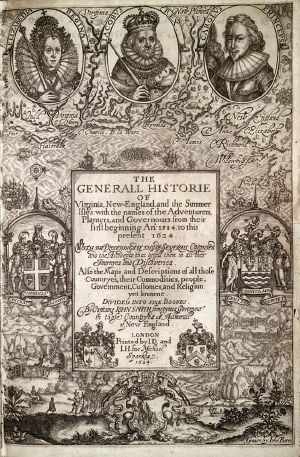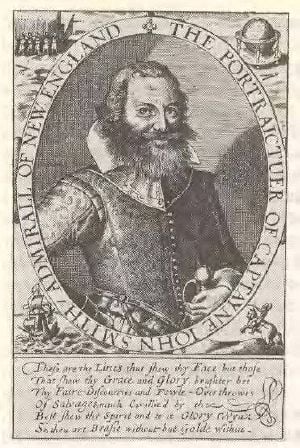Difference between revisions of "John Smith of Jamestown" - New World Encyclopedia
Laura Brooks (talk | contribs) (import, credit, version number) |
Laura Brooks (talk | contribs) |
||
| Line 1: | Line 1: | ||
[[Image:Captain_John_Smith.jpg|thumb|right|''Captain John Smith'']] | [[Image:Captain_John_Smith.jpg|thumb|right|''Captain John Smith'']] | ||
| − | '''John Andrew Smith''' ( | + | '''John Andrew Smith''' (1579 or 1580–1631) was an [[United Kingdom|English]] soldier, sailor, and author. He is remembered for his role in establishing the first permanent English settlement in [[North America]], and his brief association with the [[Native Americans in the United States|Native American]] girl [[Pocahontas]]. He was a leader of the Virginia Colony, based at Jamestown, and thus one of the first heads of government in Anglo-America. He played a critical role in successfully interacting with the Native Americans. |
| − | |||
| − | He | ||
==Early adventures== | ==Early adventures== | ||
| − | Smith was baptized in | + | Smith was baptized in Willoughby near Alford, Lincolnshire where his parents rented a farm from Lord Willoughby. Smith left home at age 16 after his father died and ran off to sea. He served as a mercenary in the army of King [[Henry IV of France]] against the Spaniards and later fought against the [[Ottoman Empire]]. Smith was promoted to captain while fighting for the Habsburgs in [[Hungary]], in the campaign of Mihai Viteazul in 1600-1601. After the death of Mihai Viteazul, he fought for Radu Serban in Wallachia against Ieremia Movila, but, in 1602 he was wounded, captured and sold as a [[slavery|slave]]. Smith claimed the [[Turkic peoples|Turk]] sent him as a gift to his sweetheart, who fell in love with Smith and inadvertently helped him escape. Smith then traveled through Europe and Northern Africa, returning to England during 1604. |
==Virginia Colony== | ==Virginia Colony== | ||
Revision as of 23:59, 20 November 2006
John Andrew Smith (1579 or 1580–1631) was an English soldier, sailor, and author. He is remembered for his role in establishing the first permanent English settlement in North America, and his brief association with the Native American girl Pocahontas. He was a leader of the Virginia Colony, based at Jamestown, and thus one of the first heads of government in Anglo-America. He played a critical role in successfully interacting with the Native Americans.
Early adventures
Smith was baptized in Willoughby near Alford, Lincolnshire where his parents rented a farm from Lord Willoughby. Smith left home at age 16 after his father died and ran off to sea. He served as a mercenary in the army of King Henry IV of France against the Spaniards and later fought against the Ottoman Empire. Smith was promoted to captain while fighting for the Habsburgs in Hungary, in the campaign of Mihai Viteazul in 1600-1601. After the death of Mihai Viteazul, he fought for Radu Serban in Wallachia against Ieremia Movila, but, in 1602 he was wounded, captured and sold as a slave. Smith claimed the Turk sent him as a gift to his sweetheart, who fell in love with Smith and inadvertently helped him escape. Smith then traveled through Europe and Northern Africa, returning to England during 1604.
Virginia Colony

In 1606, Smith became involved with plans to colonize Virginia for profit by the Virginia Company of London, which had been granted a charter from King James I of England. The expedition set sail in three small ships on December 20, 1606.
Smith was apparently a troublemaker on the voyage, and Captain Christopher Newport (in charge of the three ships) had planned to execute him upon arrival in Virginia. However, upon first landing at what is now Cape Henry on April 26, 1607, sealed orders from the Virginia Company were opened. They designated Smith to be one of the leaders of the new colony, forcing Newport to spare him. After searching for a suitable site, on May 13, 1607, the settlers landed at Jamestown.
Harsh weather, lack of water and attacks from Algonquian tribes of the Native Americans almost destroyed the colony. In December 1607, Smith was captured and taken to meet the Chief Powhatan at Werowocomoco, the chief village of the Powhatan Confederacy about 15 miles north of Jamestown on the north shore of the York River. Although he feared for his life, Smith was eventually released without harm and later attributed this in part to the chief's daughter, Pocahontas, who, according to Smith, threw herself across his body[1]: "at the minute of my execution, she hazarded [i.e. risked] the beating out of her own brains to save mine; and not only that, but so prevailed with her father, that I was safely conducted to Jamestown".[2]
Smith's version of events is the only source, and since the 1860s, skepticism has increasingly been expressed about its veracity. One reason for such doubt is that despite having published two earlier books about Virginia, Smith's earliest surviving account of his rescue by Pocahontas dates from 1616, nearly 10 years later, in a letter entreating Queen Anne to treat Pocahontas with dignity [3]. The time gap in publishing his story raises the possibility that Smith may have exaggerated or invented the event to enhance Pocahontas' image. However, in a recent book, J.A.O. Lemay points out that Smith's earlier writing was primarily geographical and ethnographic in nature and did not dwell on his personal experiences, hence there was no reason for him to write down the story until this point.[4]
Some experts have suggested that, although Smith believed he had been rescued, he had in fact been involved in a ritual intended to symbolise his death and rebirth as a member of the tribe [5]. However, in Love and Hate in Jamestown, David A. Price notes that this is only guesswork, since little is known of Powhatan rituals, and there is no evidence for any similar rituals among other North American tribes (p. 243-4).
Whatever really happened, the encounter initiated a friendly relationship with Smith and the Jamestown colony. As the colonists expanded further, however, some of the Native Americans felt that their lands were threatened, and conflicts arose again.
In 1608, Pocahontas is said to have saved Smith a second time. Smith and some other colonists were invited to Werowocomoco by Chief Powhatan on friendly terms, but Pocahontas came to the hut where the English were staying and warned them that Powhatan was planning to kill them. Due to this warning, the English stayed on their guard, and the attack never came.[6]
Later, Smith left Jamestown to explore the Chesapeake Bay region and search for badly-needed food, covering an estimated 3,000 miles. He was eventually elected president of the local council in September 1608 and instituted a policy of discipline, encouraging farming with a famous admonishment: "He who does not work, will not eat."
The settlement grew under his leadership. During this period, Smith took the chief of the neighboring tribe hostage and, according to Smith he did, "take this murdering Opechancanough...by the long lock of his head; and with my pistol at his breast, I led him {out of his house} amongst his greatest forces, and before we parted made him [agree to] fill our bark with twenty tons of corn."[citation needed] A year later, full scale war broke out between the Powhatans and the Virginia colonists. Smith was seriously injured by a gunpowder burn after a rogue spark landed in his powder keg. It is not known whether the injury was an accident or a murder attempt. He returned to England for treatment in Oct. 1609, never to return to Virginia.
New England
In 1614, Smith returned to the New World in a voyage to coasts of Maine and Massachusetts Bay, an area which he named New England.[citation needed] His second attempted voyage to the New England coast in 1615 was interrupted by his capture by French pirates off the Azores. Smith escaped after weeks of captivity and made his way back to England, where he published an account of his two voyages as A Description of New England. He never left England again, and spent the rest of his life writing books. He died in 1631 at age 51.
Publications
- A True Relation of Such Occurrences and Accidents of Note as Happened in Virginia (1608)
- A Map of Virginia (1612)
- The Proceedings of the English Coony in Virginia (1612)
- A Description of New England (1616)
- New England's Trials (1620, 1622)
- The General History of Virginia, New England, and the Summer Isles (1624)
- An Accidence, or the Pathway to Experience Necessary for all Young Seamen (1626)
- A Sea Grammar (1627)
- The True Travels, Adventures and Observations of Captain John Smith (1630)
- Advertisements for the Unexperienced Planters of New England, or Anywhere (1631)
John Smith in film
- John Smith is one of the main characters in Disney's 1995 film Pocahontas and its straight-to-video sequel Pocahontas II: Journey to a New World in which he is voiced by Mel Gibson in the first movie and his younger brother Donal Gibson in the sequel.
- Smith and Pocahontas are also central characters in the Terrence Malick film The New World, in which he is portrayed by Colin Farrell.
Notes
- ↑ Smith, Generall Historie
- ↑ Smith. Letter to Queen Anne.
- ↑ Smith. Letter to Queen Anne.
- ↑ Lemay. Did Pocahontas, p. 25. Lemay's other arguments in favour of Smith are summarised in Birchfield, 'Did Pocahontas'.
- ↑ Gleach, Powhatan's World, pp. 118-21.; Kupperman, Indians and English, pp. 114, 174.
- ↑ Symonds, Proceedings, pp. 251-2; Smith, Generall Historie, pp. 198-9, 259.
Further reading
- Philip L. Barbour, The Jamestown Voyages under the First Charter, 1606-1609, 2 vols., Publications of the Hakluyt Society, ser.2, 136-37 (Cambridge: Cambridge University Press, 1969)
- Philip L. Barbour, The Three Worlds of Captain John Smith (Boston: Houghton Mifflin, 1964)
- Gleach, Frederic W. Powhatan's World and Colonial Virginia. Lincoln: University of Nebraska Press, 1997.
- Dorothy Hoobler and Thomas Hoobler, Captain John Smith: Jamestown and the Birth of the American Dream (Hoboken, N.J.: John Wiley & Sons, 2006)
- Horn, James. A Land as God Made It: Jamestown and the Birth of America (New York: Basic Books, 2005)
- Kupperman, Karen Ordahl ed., John Smith: A Select Edition of His Writings (Chapel Hill: University of North Carolina Press, 1988)
- Price, David A., Love and Hate in Jamestown: John Smith, Pocahontas, and the Heart of a New Nation (New York: Knopf, 2003)
- Lemay, J.A. Leo. Did Pocahontas Save Captain John Smith? Athens, Georgia: The University of Georgia Press, 1992, p. 25.
- John Smith, The Complete Works of Captain John Smith (1580-1631) in Three Volumes, edited by Philip L. Barbour, 3 vols. (Chapel Hill: University of North Carolina Press for The Institute of Early American History and Culture, Williamsburg, 1986)
- Smith, John. The Generall Historie of Virginia, New-England, and the Summer Isles. 1624. Repr. in Jamestown Narratives, ed. Edward Wright Haile. Champlain, VA: Roundhouse, 1998. pp. 198-9, 259.
- Smith, John. Letter to Queen Anne. 1616. Repr. as 'John Smith's Letter to Queen Anne regarding Pocahontas'. Caleb Johnson's Mayflower Web Pages. 1997. Accessed 23 April, 2006.
- Symonds, William. The Proceedings of the English Colonie in Virginia. 1612. Repr. in The Complete Works of Captain John Smith. Ed. Philip L. Barbour. Chapel Hill: University of North Carolina Press, 1986. Vol. 1, pp. 251-2
- Warner, Charles Dudley, Captain John Smith, 1881. Repr. in Captain John Smith Project Gutenberg Text, accessed 4 July, 2006
External links
- Captain John Smith Trail in Virginia
- John Smith Water Trail Blog
- The Captain John Smith Water Trail
- A Description of New England (1616) online text (PDF)
| Preceded by: Matthew Scrivener |
Colonial Governor of Virginia 1608-1609 |
Succeeded by: George Percy |
credit|83941768}}

